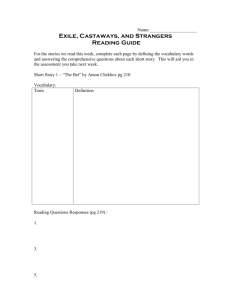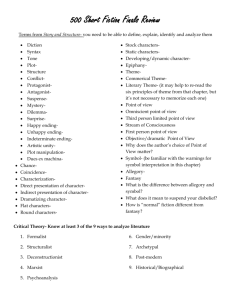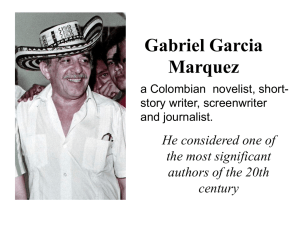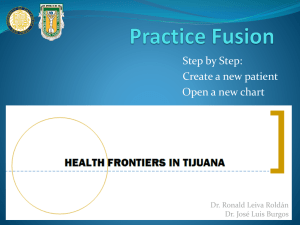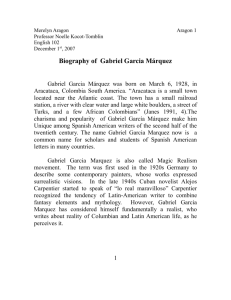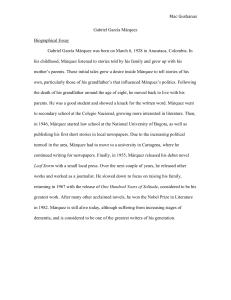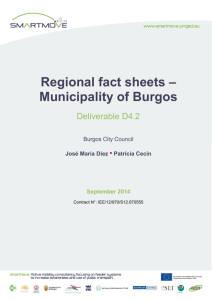AP Spanish Literature
advertisement
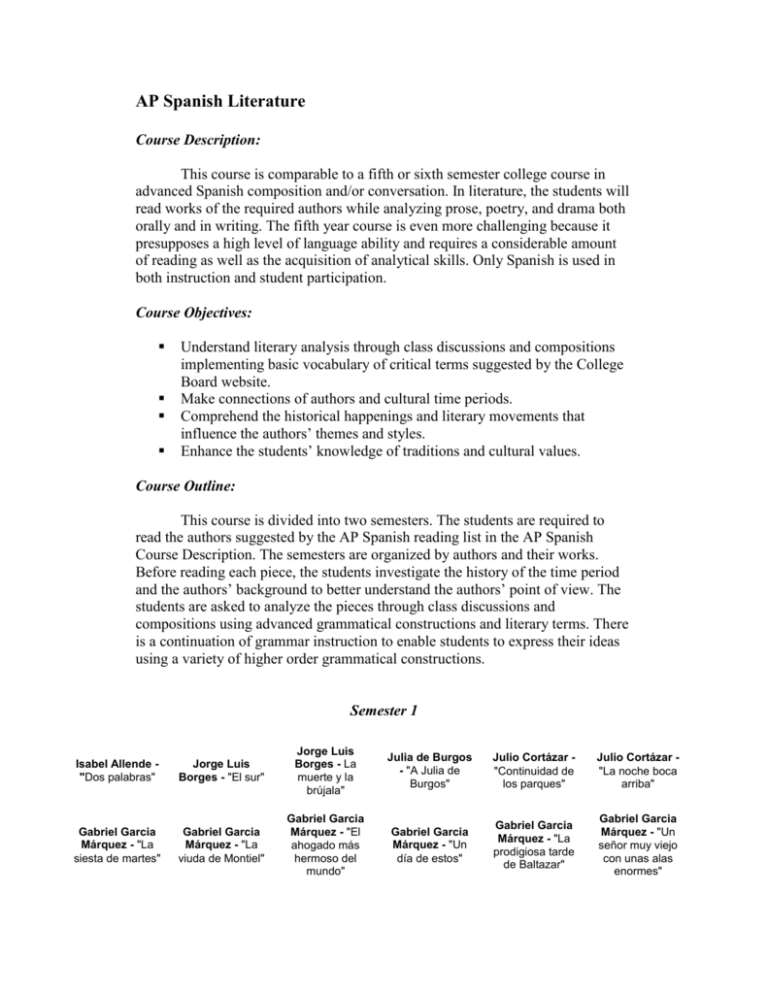
AP Spanish Literature Course Description: This course is comparable to a fifth or sixth semester college course in advanced Spanish composition and/or conversation. In literature, the students will read works of the required authors while analyzing prose, poetry, and drama both orally and in writing. The fifth year course is even more challenging because it presupposes a high level of language ability and requires a considerable amount of reading as well as the acquisition of analytical skills. Only Spanish is used in both instruction and student participation. Course Objectives: Understand literary analysis through class discussions and compositions implementing basic vocabulary of critical terms suggested by the College Board website. Make connections of authors and cultural time periods. Comprehend the historical happenings and literary movements that influence the authors’ themes and styles. Enhance the students’ knowledge of traditions and cultural values. Course Outline: This course is divided into two semesters. The students are required to read the authors suggested by the AP Spanish reading list in the AP Spanish Course Description. The semesters are organized by authors and their works. Before reading each piece, the students investigate the history of the time period and the authors’ background to better understand the authors’ point of view. The students are asked to analyze the pieces through class discussions and compositions using advanced grammatical constructions and literary terms. There is a continuation of grammar instruction to enable students to express their ideas using a variety of higher order grammatical constructions. Semester 1 Isabel Allende "Dos palabras" Jorge Luis Borges - "El sur" Jorge Luis Borges - La muerte y la brújala" Julia de Burgos - "A Julia de Burgos" Julio Cortázar "Continuidad de los parques" Julio Cortázar "La noche boca arriba" Gabriel Garcia Márquez - "La siesta de martes" Gabriel Garcia Márquez - "La viuda de Montiel" Gabriel Garcia Márquez - "El ahogado más hermoso del mundo" Gabriel Garcia Márquez - "Un día de estos" Gabriel Garcia Márquez - "La prodigiosa tarde de Baltazar" Gabriel Garcia Márquez - "Un señor muy viejo con unas alas enormes" Semester 1 (continued) Horacio Quiroga - "El hijo" Sabine Ulibarri "Mi caballo mago" Juan Manuel, Infante de Castilla "Conde Lucanor: Exemplo XXXV" José de Espronceda "Canción del pirata" José María Heredia "En una tempestad" Emilia Pardo Bazán -"Las medias rojas" Carlos Fuentes "Chac mool" Nicolás Guillén "Balada de los dos abuelos" Anónimo "Romance del Conde Arnaldos" Gracilaso de la Vega - "Soneto XXIII ("En tanto que de rosa y de azucena") Francisco de Quevedo y Villegas "Heráclito cristiano: Salmo XVII ("Mire los muros …" Gabriel (Tirso de Molina) Téllez El burlador de Sevilla y convidado de piedra" Anónimo "Romance de la pérdida de Alhama" Gustavo Adolfo Bécquer "Rimas IV". Gustavo Adolfo Bécquer "Rimas XI". Gustavo Adolfo Bécquer "Rimas LIII". Nicolás Guillén "Sensemayá" Semester 2 Anónimo "Lazarillo del Tormes" Tratados 1,2,3, 7 Cervantes Capítulos I, II, III, IV, V, VIII Sor Juana Inés de la Cruz - "En perseguirme, ¿qué interesas? Sor Juana Inés de la Cruz "Hombres necios que acusáis" Julia de Burgos - "A Julia de Burgos" Rosario de Castellanos "Autorretrato" Luis de Góngora y Argote "Soneto CLXVI ("Mientras por competir con tu cabello") Juan Manuel, Infante de Castilla "Conde Lucanor: Exemplo XXXV" Alvar Núñez Cabeza de Vaca - "Naufragios Cap. XII" Alvar Núñez Cabeza de Vaca - "Naufragios Cap. XX" Alvar Núñez Cabeza de Vaca - "Naufragios Cap. XXI" Miguel de Unamuno y Jugo - "San Manuel Bueno, mártir Antonio Machado - "La primavera besaba" Antonio Machado "Caminante, son tus abuelos" Pablo Neruda "Oda a la alcachofa" Alfonsina Storni - "Peso ancestral" Alfonsina Storni - "Tú me quieres blanca" Antonio Machado - "He andado muchos caminos" Juan Rulfo "No oyes ladrar los perros" José Martí "Dos patrias" José Martí "Versos sencillos" Ricardo Palma "El alacrán de Fray Gomez" Federico Garcia Lorca - "La casa de Bernarda Alba" Mariano José de Larra - "Vuelva Ud. mañana" Pablo Neruda "Residencia en la Tierra 2, "Walking around" Federico Garcia Lorca - "Dos romances del Romancero gitano" Pablo Neruda Veinte poemas de amor… Poema 15 "Me gustas cuando callas…" Student Activities: The goals for the student activities are: 1. Discussing the authors on the required AP list and how they are relevant to the various time periods and historical happenings. 2. Studying the various authors’ lives and how their personal challenges are reflected in the various themes found in their works. 3. Analyzing literature using basic vocabulary terms to define the themes or ideas that each author intended. 4. Connecting the students’ previous knowledge of literature and expanding it using the Spanish and Latin American literature. 5. Analyzing literature to connect the students’ experiences with the universal themes reflected in the literary works. 6. Using literary analysis to expand the students’ knowledge by integrating speaking and writing activities. All course work is done in Spanish. The students and teacher are required to only use Spanish in class discussions and writing activities. 30 % of the students’ grade is class participation. Students are penalized if English is used. Sample Student Activities: 1. The following is a sample from the packet given to each student at the beginning of the school year. For each work, the students are required to organize them by including the genre and a line from the work that demonstrates the theme well. When the line is chosen, the students write a reaction that explains the importance of it in comparison to the work. This project allows the students to use critical and analytical skills to communicate their ideas in the target language. La Edad Media Género Cita de la obra Página Anónimo “Romance de la pérdida de Alhama” (“Ay de mi Alhama”) Escribe una reacción que explica la importancia de la cita escogida a la obra (Composición de 75-100 palabras) 2. This class also uses team-building activities. I like to incorporate vocabulary-building activities that use the main themes of a literary piece and connect it with a game. For one game, we do the following: a. We first brainstorm the various themes of a work. b. Then, we choose a main theme of the reading. c. The students are then put into two groups. d. One student from each group is asked to be the secretary for his/her group. e. The students are allowed to use the text in this game. f. The students are asked to look for words that demonstrate the theme. g. The two groups shout out the first word and the secretary writes it on the board. h. The next word chosen has to begin with the second letter of the word written. i. The teams continue shouting out words found from the text while the secretary writes them down. j. The team that cannot build a word from the previous one loses. When we are finished, we look at each list to see if the words truly reflect the theme. This allows the students to reconnect with the text and also helps generate a great class discussion. We count up the amount of relevant words and the team with the most words wins. 3. Compositions are also used in this class to demonstrate the students’ analytical skills. A variety of essay types is used each modeling after the AP literature exam. The essay topics suggested by the Abriendo Puertas book series are used frequently. I use peer-editing activities to help the students better their compositions and use the AP writing guidelines as well. 4. Timed essays are also used during class. The students receive the topic and 40 minutes to write it. The AP writing guidelines are used along with my own rubric. 5. Practice exams are used to help students analyze reading samples. The students are also timed in these activities. Bibliography Abriendo Puertas Antología de literature en español Tomo I. Illinois: Nextext, 2003. Abriendo Puertas Antología de literature en español Tomo II. Illinois: Nextext, 2003. Adey, Margaret, and Louis Albini. Tesoro Literario. New York: Glencoe McGraw-Hill, 1997. Colbert, Ana, María Colbert, Abby Kanter, Marisol Maura, and Marian Sugano. Azulejo. MA: Wayside, 2002. Leech, Mary. Cracking the AP Spanish Exam. New York: Random House Inc., 2006. Zayas-Bazán, Eduardo, Susan M. Bacon, and Dulce García. Conexiones. New Jersey: Prentice Hall, 1999.
